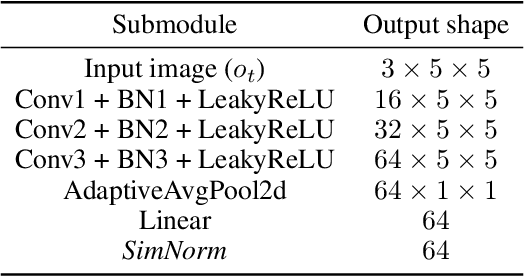Zhenjie Yang
UniZero: Generalized and Efficient Planning with Scalable Latent World Models
Jun 15, 2024



Abstract:Learning predictive world models is essential for enhancing the planning capabilities of reinforcement learning agents. Notably, the MuZero-style algorithms, based on the value equivalence principle and Monte Carlo Tree Search (MCTS), have achieved superhuman performance in various domains. However, in environments that require capturing long-term dependencies, MuZero's performance deteriorates rapidly. We identify that this is partially due to the \textit{entanglement} of latent representations with historical information, which results in incompatibility with the auxiliary self-supervised state regularization. To overcome this limitation, we present \textit{UniZero}, a novel approach that \textit{disentangles} latent states from implicit latent history using a transformer-based latent world model. By concurrently predicting latent dynamics and decision-oriented quantities conditioned on the learned latent history, UniZero enables joint optimization of the long-horizon world model and policy, facilitating broader and more efficient planning in latent space. We demonstrate that UniZero, even with single-frame inputs, matches or surpasses the performance of MuZero-style algorithms on the Atari 100k benchmark. Furthermore, it significantly outperforms prior baselines in benchmarks that require long-term memory. Lastly, we validate the effectiveness and scalability of our design choices through extensive ablation studies, visual analyses, and multi-task learning results. The code is available at \textcolor{magenta}{https://github.com/opendilab/LightZero}.
Bench2Drive: Towards Multi-Ability Benchmarking of Closed-Loop End-To-End Autonomous Driving
Jun 06, 2024Abstract:In an era marked by the rapid scaling of foundation models, autonomous driving technologies are approaching a transformative threshold where end-to-end autonomous driving (E2E-AD) emerges due to its potential of scaling up in the data-driven manner. However, existing E2E-AD methods are mostly evaluated under the open-loop log-replay manner with L2 errors and collision rate as metrics (e.g., in nuScenes), which could not fully reflect the driving performance of algorithms as recently acknowledged in the community. For those E2E-AD methods evaluated under the closed-loop protocol, they are tested in fixed routes (e.g., Town05Long and Longest6 in CARLA) with the driving score as metrics, which is known for high variance due to the unsmoothed metric function and large randomness in the long route. Besides, these methods usually collect their own data for training, which makes algorithm-level fair comparison infeasible. To fulfill the paramount need of comprehensive, realistic, and fair testing environments for Full Self-Driving (FSD), we present Bench2Drive, the first benchmark for evaluating E2E-AD systems' multiple abilities in a closed-loop manner. Bench2Drive's official training data consists of 2 million fully annotated frames, collected from 10000 short clips uniformly distributed under 44 interactive scenarios (cut-in, overtaking, detour, etc), 23 weathers (sunny, foggy, rainy, etc), and 12 towns (urban, village, university, etc) in CARLA v2. Its evaluation protocol requires E2E-AD models to pass 44 interactive scenarios under different locations and weathers which sums up to 220 routes and thus provides a comprehensive and disentangled assessment about their driving capability under different situations. We implement state-of-the-art E2E-AD models and evaluate them in Bench2Drive, providing insights regarding current status and future directions.
A Survey of Large Language Models for Autonomous Driving
Nov 02, 2023Abstract:Autonomous driving technology, a catalyst for revolutionizing transportation and urban mobility, has the tend to transition from rule-based systems to data-driven strategies. Traditional module-based systems are constrained by cumulative errors among cascaded modules and inflexible pre-set rules. In contrast, end-to-end autonomous driving systems have the potential to avoid error accumulation due to their fully data-driven training process, although they often lack transparency due to their ``black box" nature, complicating the validation and traceability of decisions. Recently, large language models (LLMs) have demonstrated abilities including understanding context, logical reasoning, and generating answers. A natural thought is to utilize these abilities to empower autonomous driving. By combining LLM with foundation vision models, it could open the door to open-world understanding, reasoning, and few-shot learning, which current autonomous driving systems are lacking. In this paper, we systematically review a research line about \textit{Large Language Models for Autonomous Driving (LLM4AD)}. This study evaluates the current state of technological advancements, distinctly outlining the principal challenges and prospective directions for the field. For the convenience of researchers in academia and industry, we provide real-time updates on the latest advances in the field as well as relevant open-source resources via the designated link: https://github.com/Thinklab-SJTU/Awesome-LLM4AD.
LightZero: A Unified Benchmark for Monte Carlo Tree Search in General Sequential Decision Scenarios
Oct 12, 2023



Abstract:Building agents based on tree-search planning capabilities with learned models has achieved remarkable success in classic decision-making problems, such as Go and Atari. However, it has been deemed challenging or even infeasible to extend Monte Carlo Tree Search (MCTS) based algorithms to diverse real-world applications, especially when these environments involve complex action spaces and significant simulation costs, or inherent stochasticity. In this work, we introduce LightZero, the first unified benchmark for deploying MCTS/MuZero in general sequential decision scenarios. Specificially, we summarize the most critical challenges in designing a general MCTS-style decision-making solver, then decompose the tightly-coupled algorithm and system design of tree-search RL methods into distinct sub-modules. By incorporating more appropriate exploration and optimization strategies, we can significantly enhance these sub-modules and construct powerful LightZero agents to tackle tasks across a wide range of domains, such as board games, Atari, MuJoCo, MiniGrid and GoBigger. Detailed benchmark results reveal the significant potential of such methods in building scalable and efficient decision intelligence. The code is available as part of OpenDILab at https://github.com/opendilab/LightZero.
Normalization Enhances Generalization in Visual Reinforcement Learning
Jun 01, 2023



Abstract:Recent advances in visual reinforcement learning (RL) have led to impressive success in handling complex tasks. However, these methods have demonstrated limited generalization capability to visual disturbances, which poses a significant challenge for their real-world application and adaptability. Though normalization techniques have demonstrated huge success in supervised and unsupervised learning, their applications in visual RL are still scarce. In this paper, we explore the potential benefits of integrating normalization into visual RL methods with respect to generalization performance. We find that, perhaps surprisingly, incorporating suitable normalization techniques is sufficient to enhance the generalization capabilities, without any additional special design. We utilize the combination of two normalization techniques, CrossNorm and SelfNorm, for generalizable visual RL. Extensive experiments are conducted on DMControl Generalization Benchmark and CARLA to validate the effectiveness of our method. We show that our method significantly improves generalization capability while only marginally affecting sample efficiency. In particular, when integrated with DrQ-v2, our method enhances the test performance of DrQ-v2 on CARLA across various scenarios, from 14% of the training performance to 97%.
 Add to Chrome
Add to Chrome Add to Firefox
Add to Firefox Add to Edge
Add to Edge